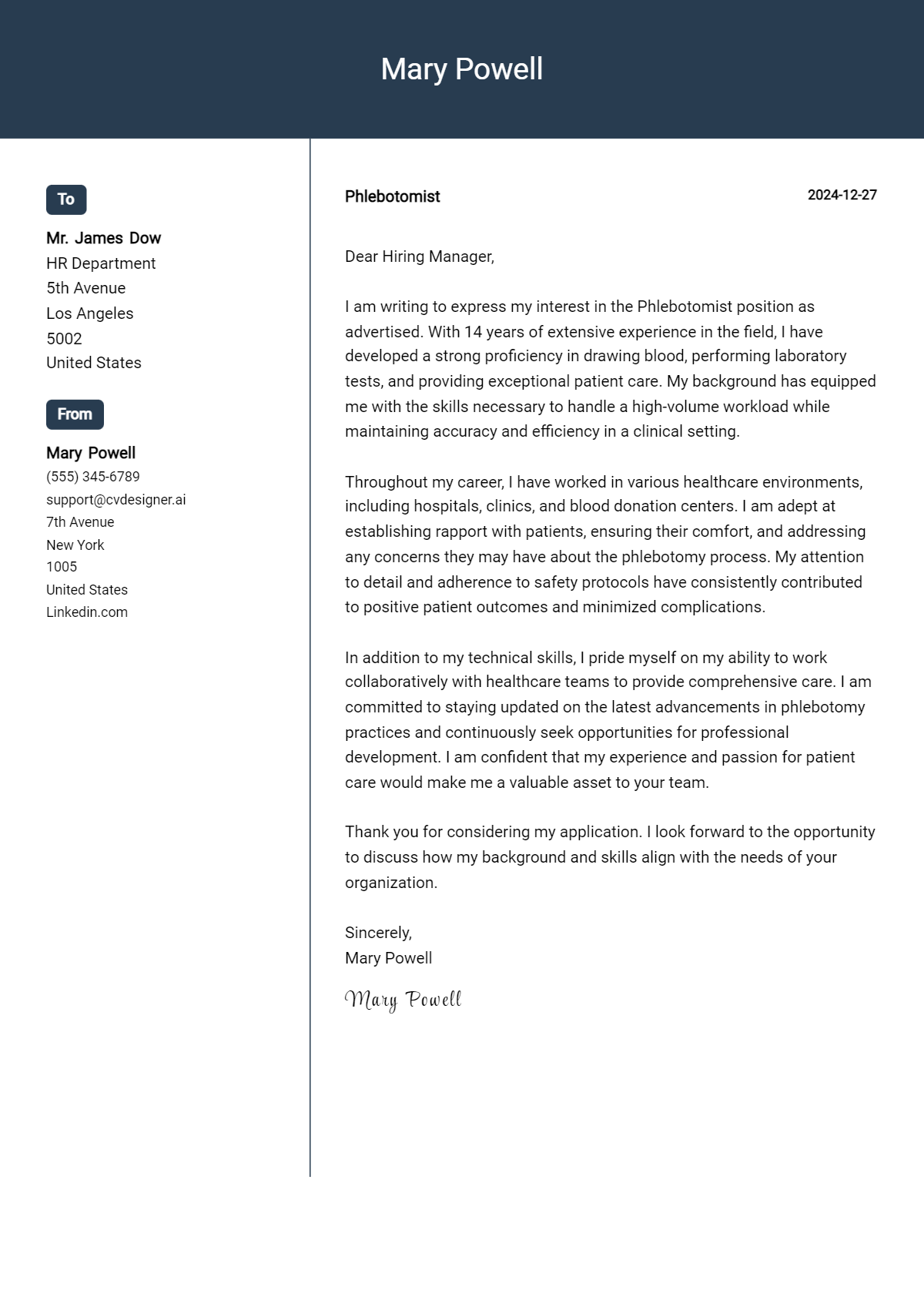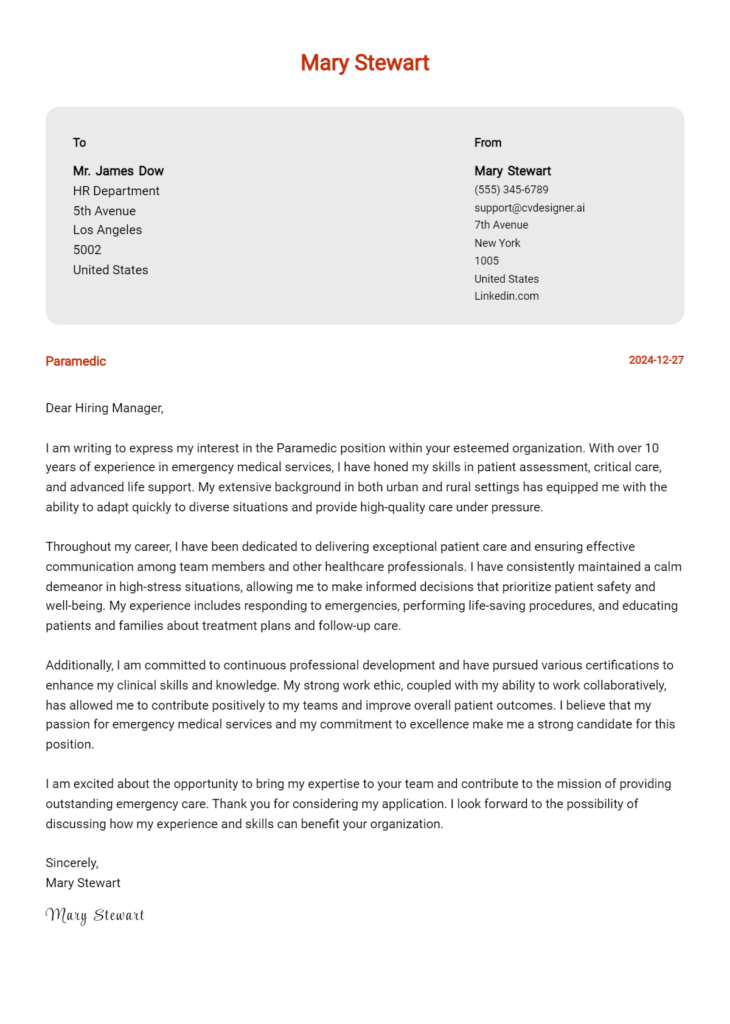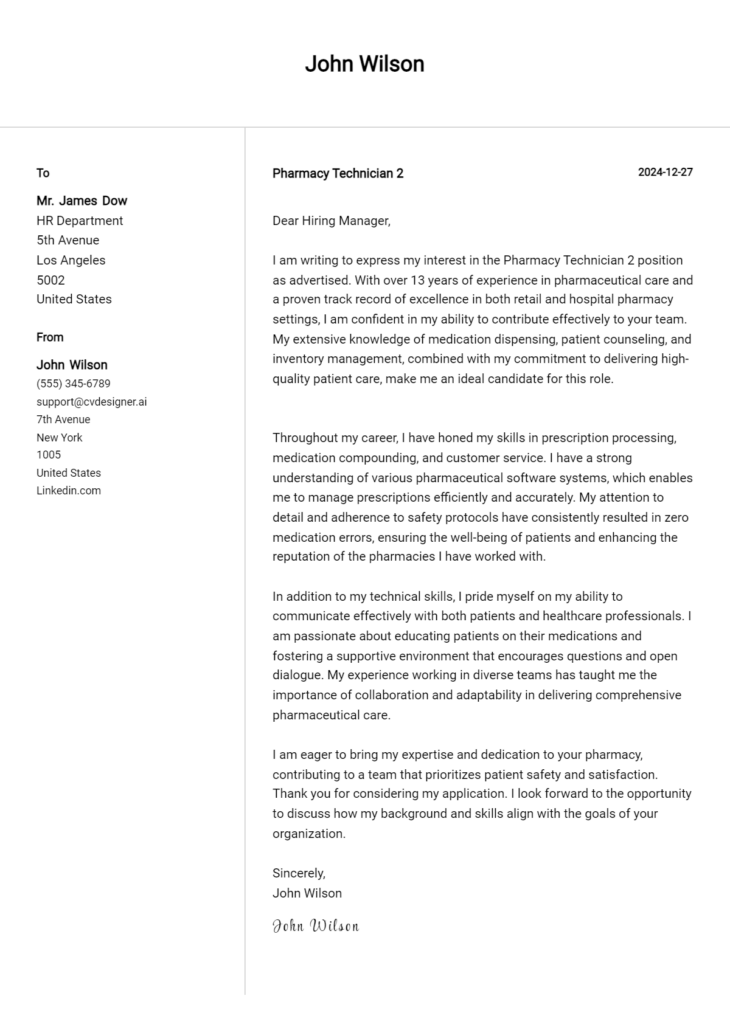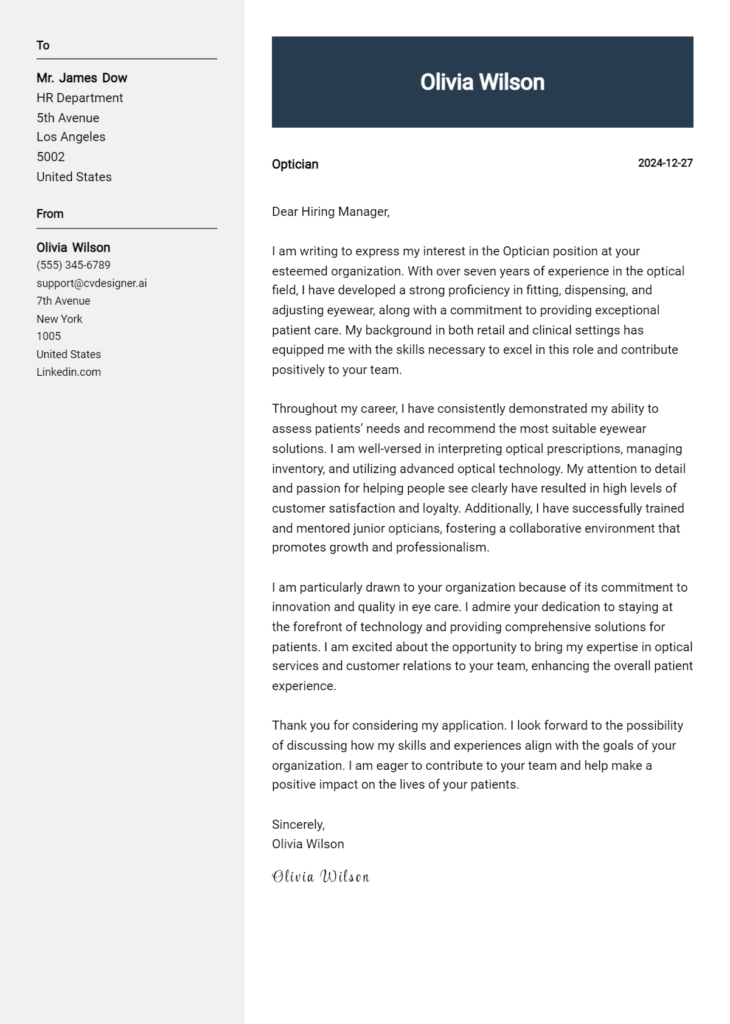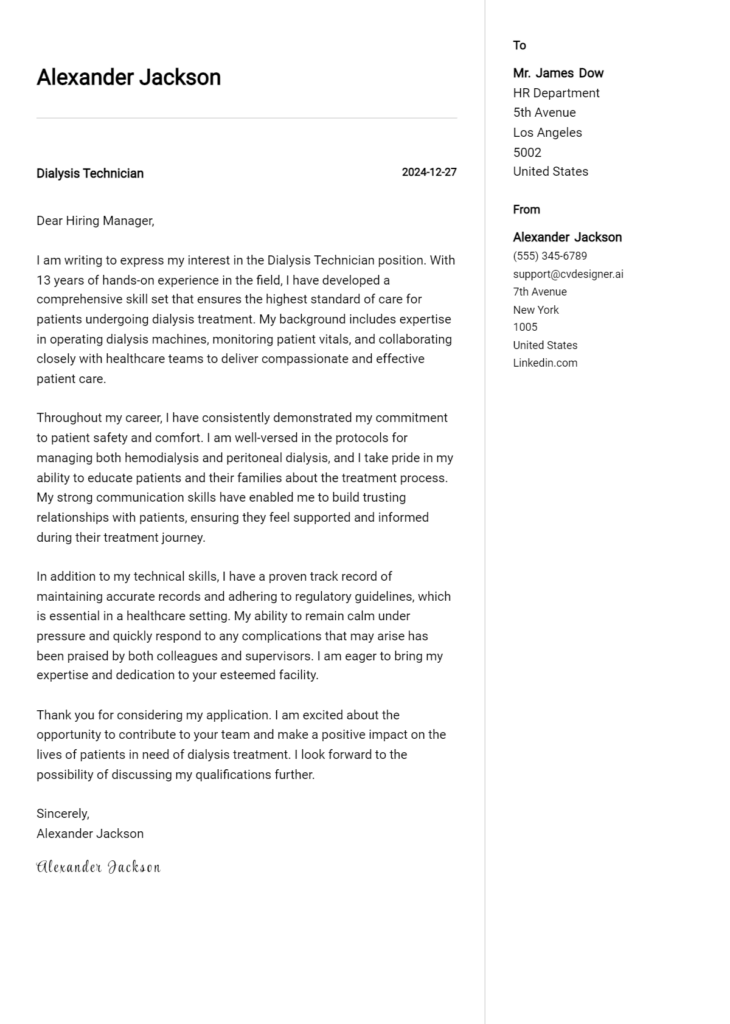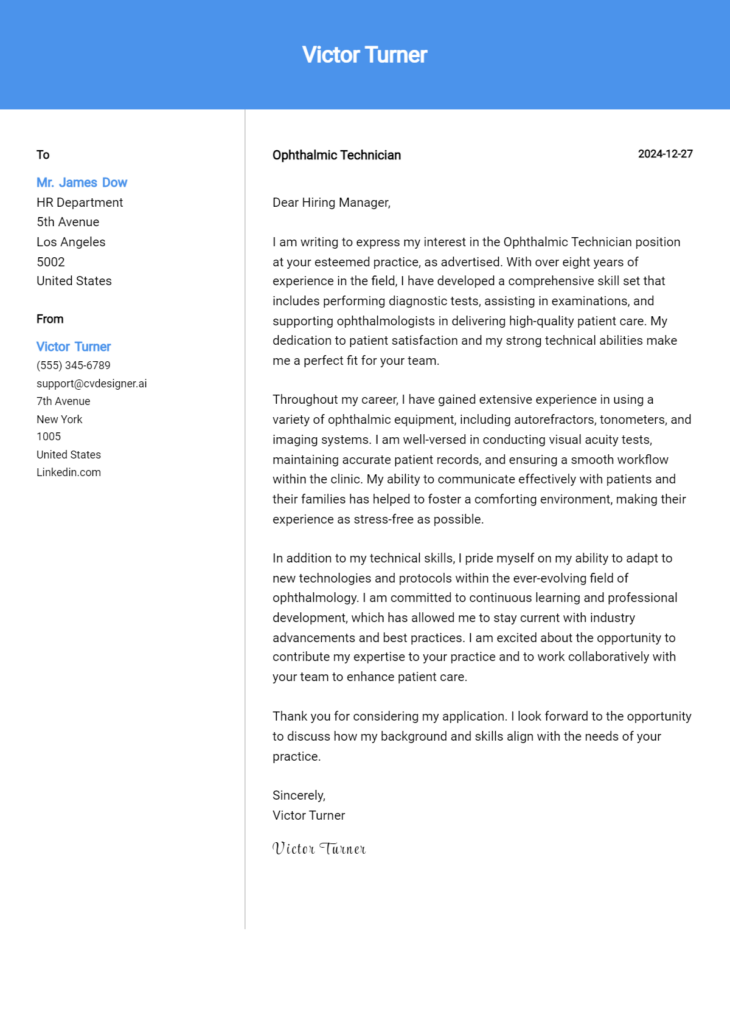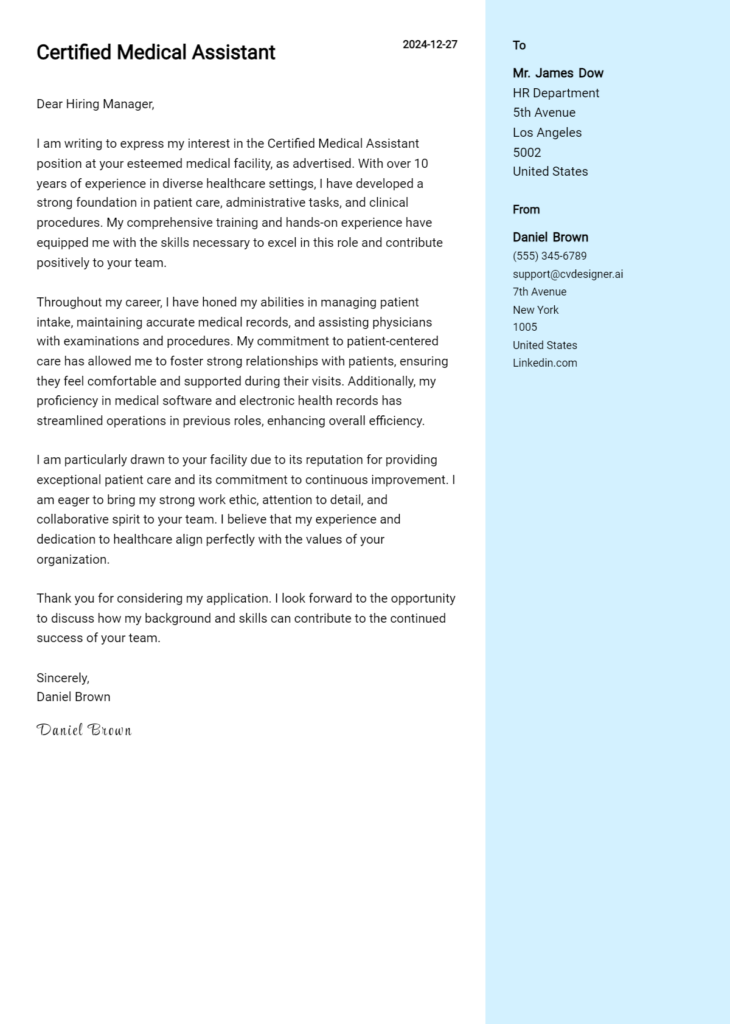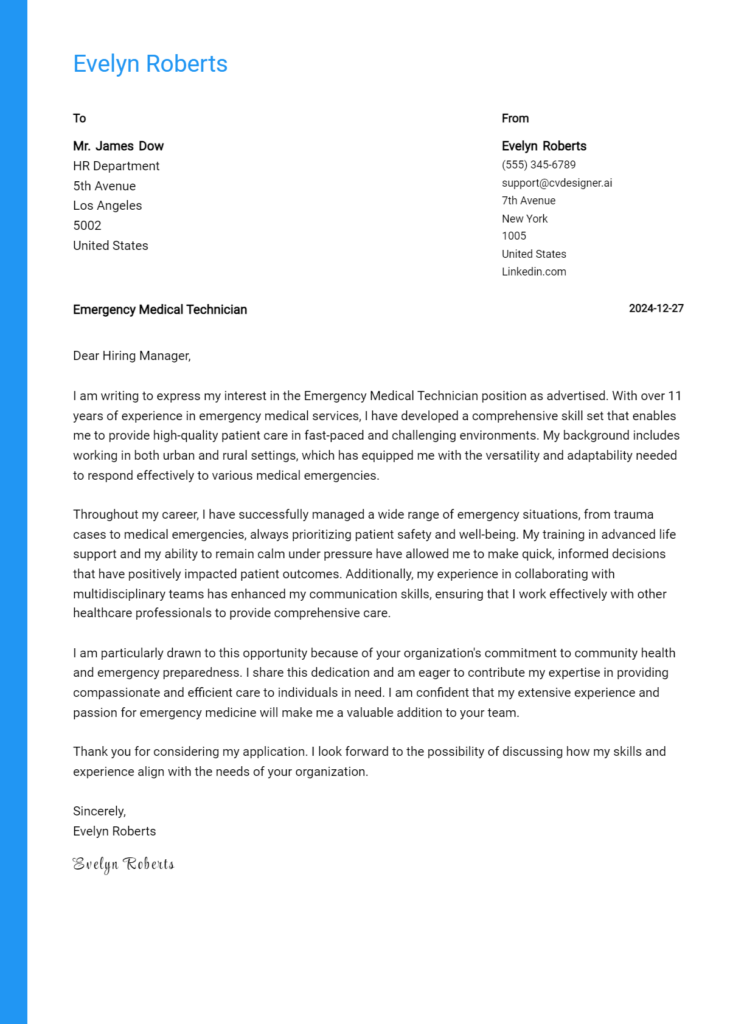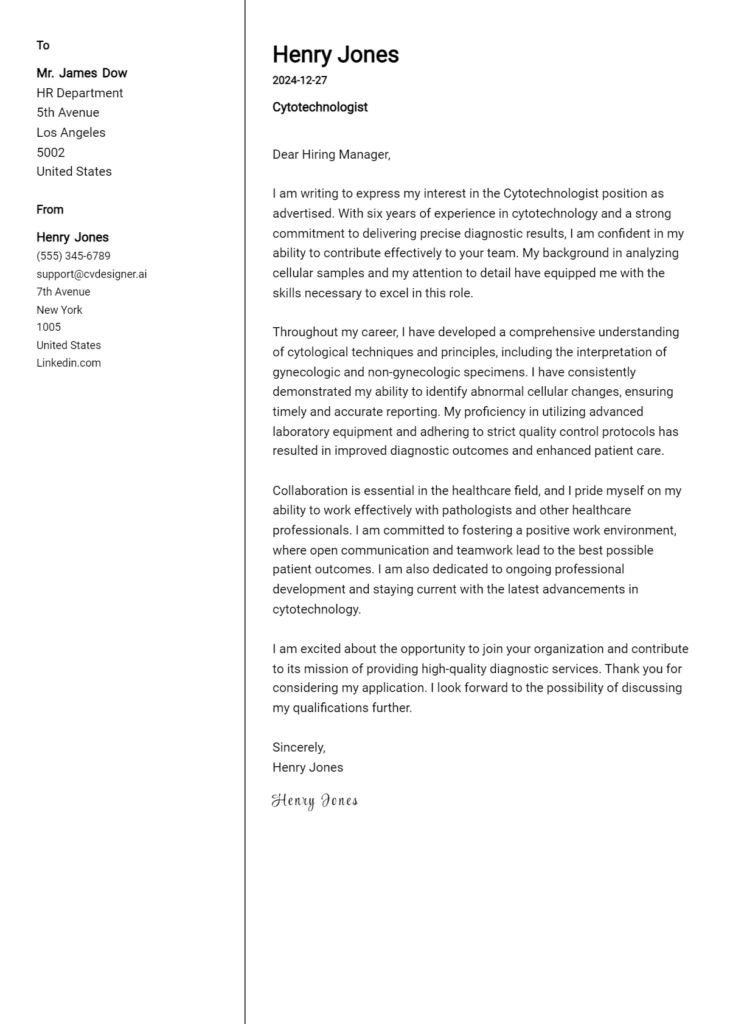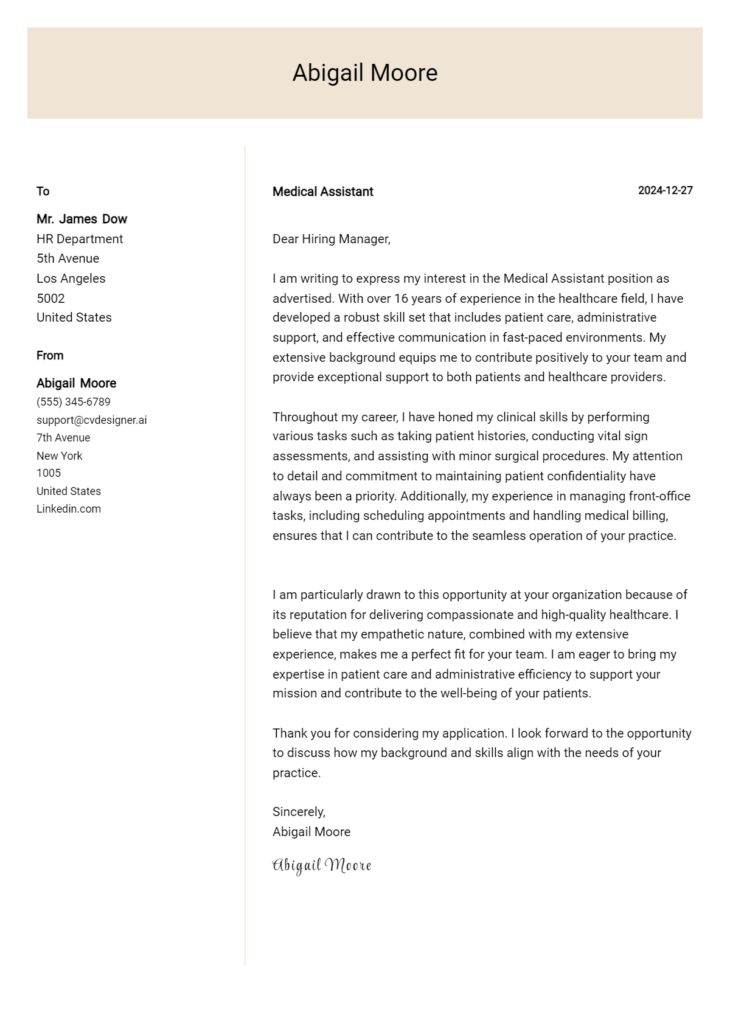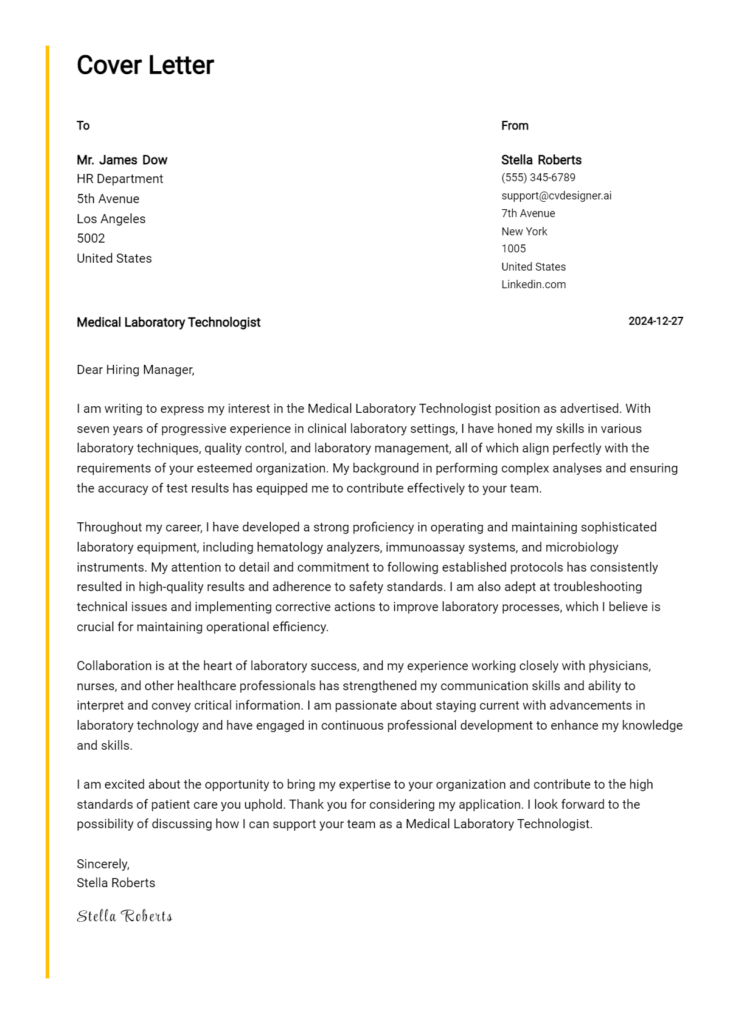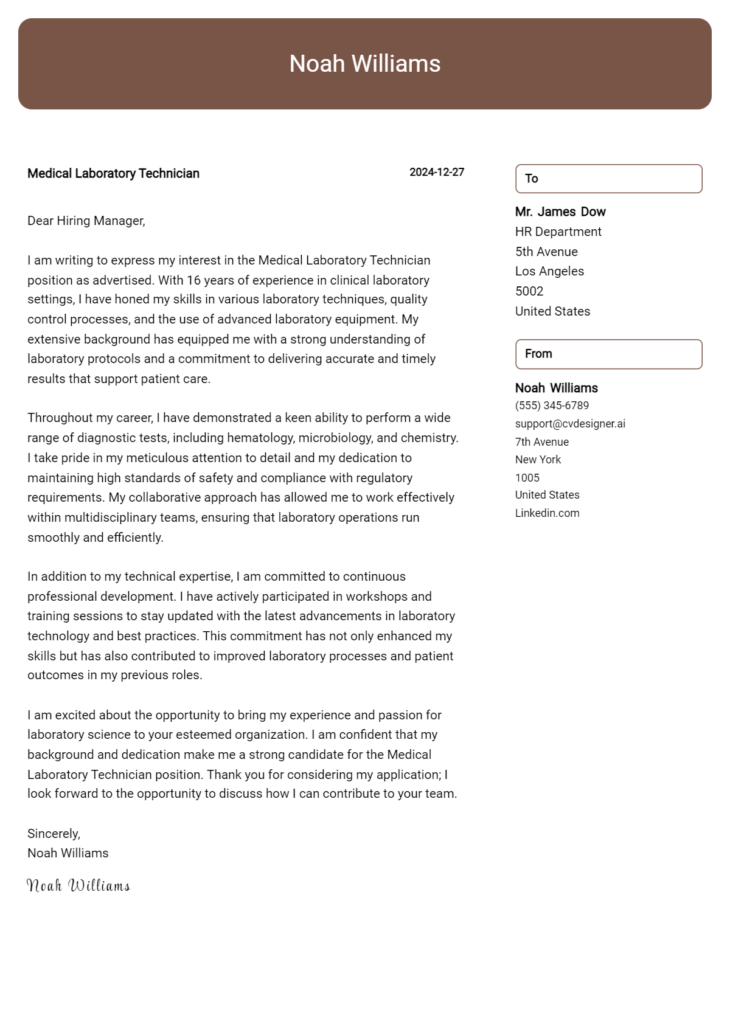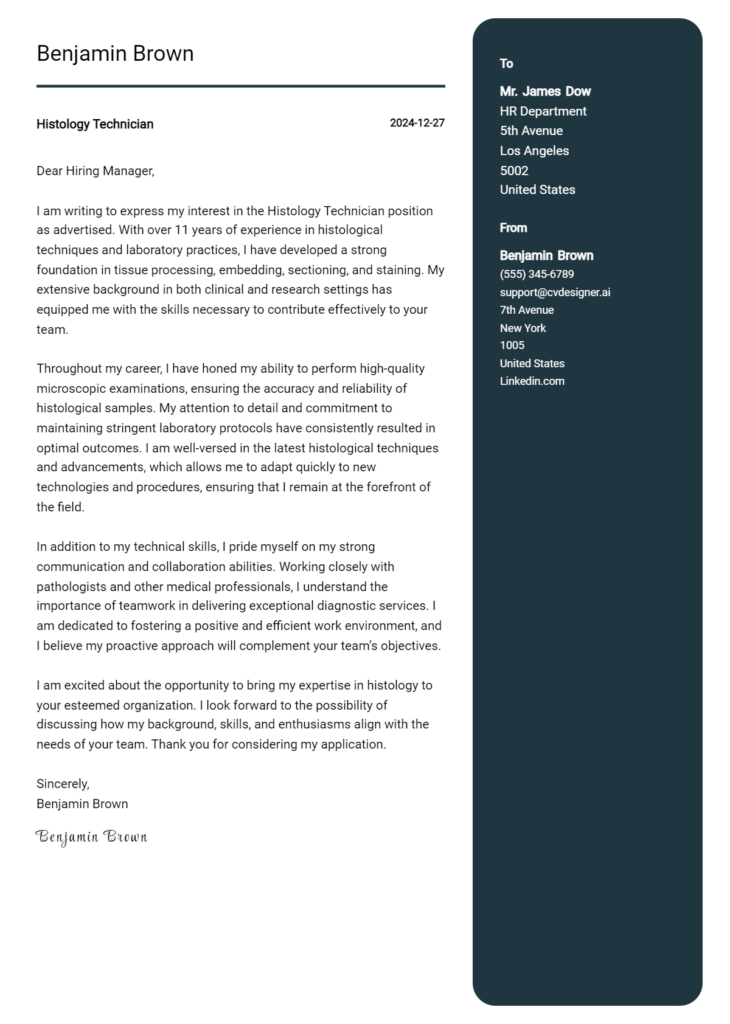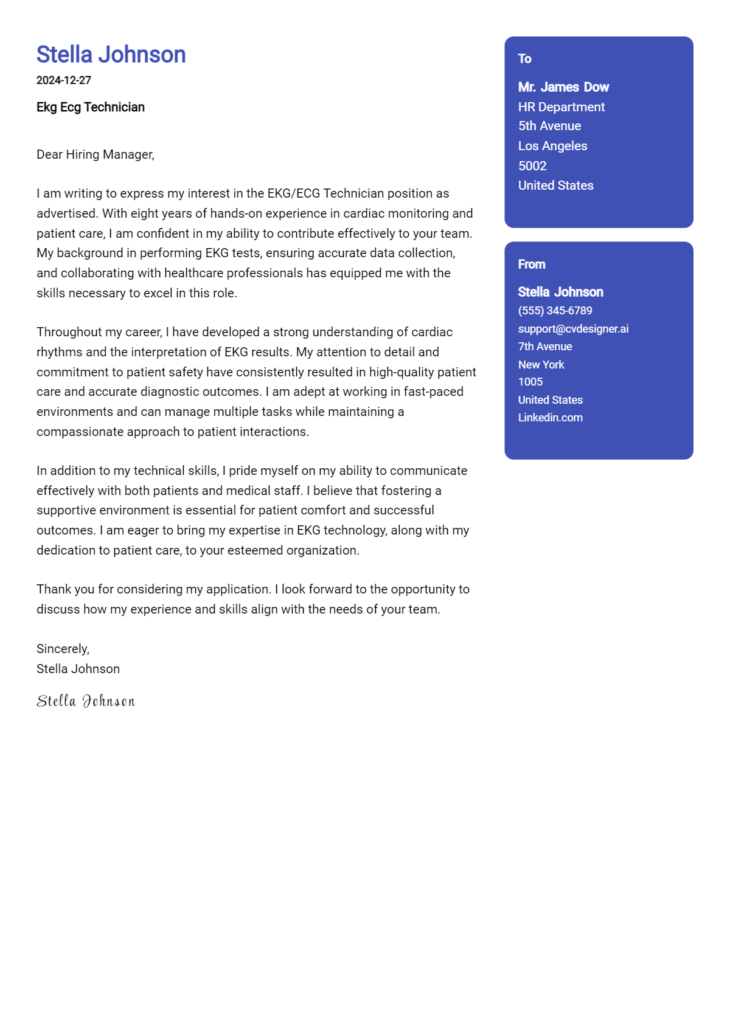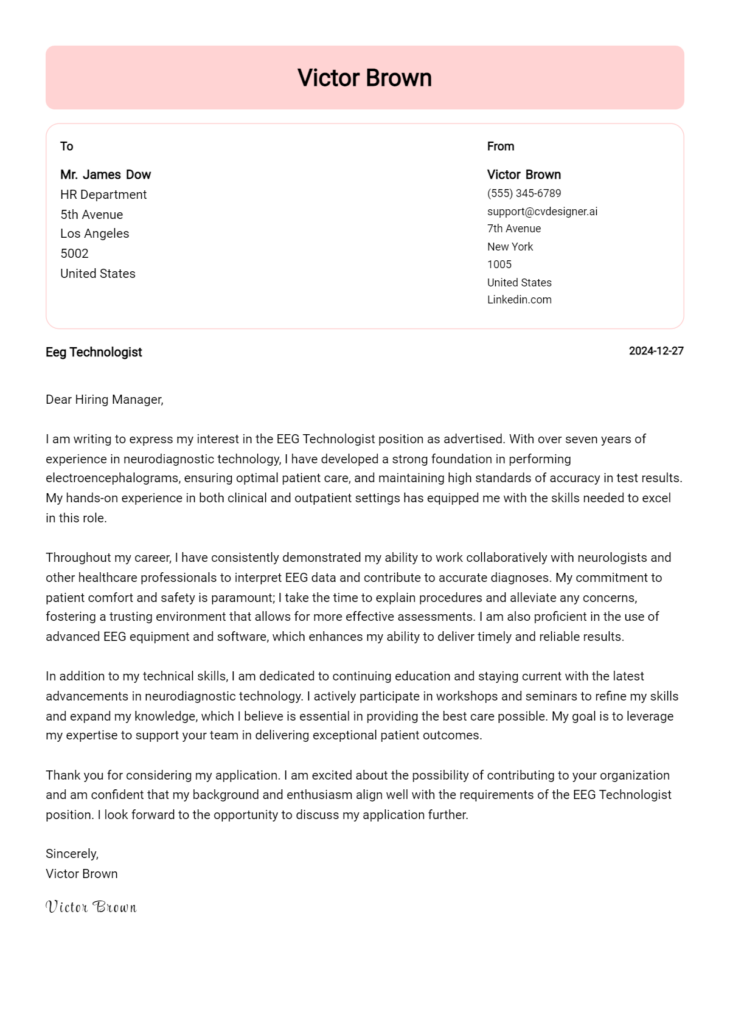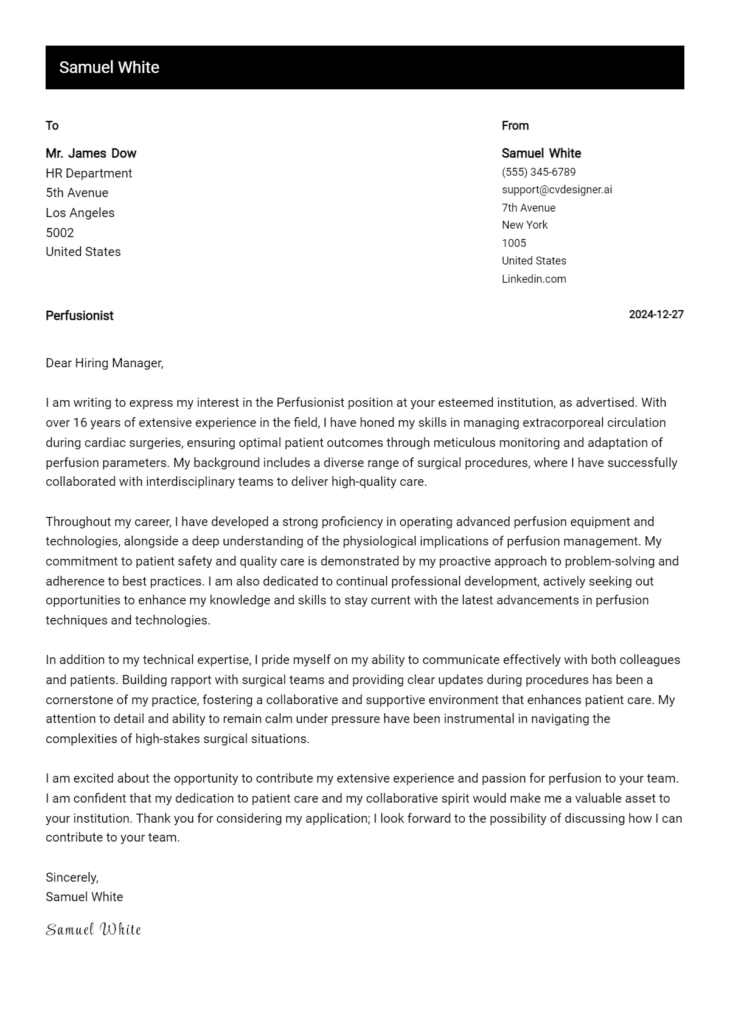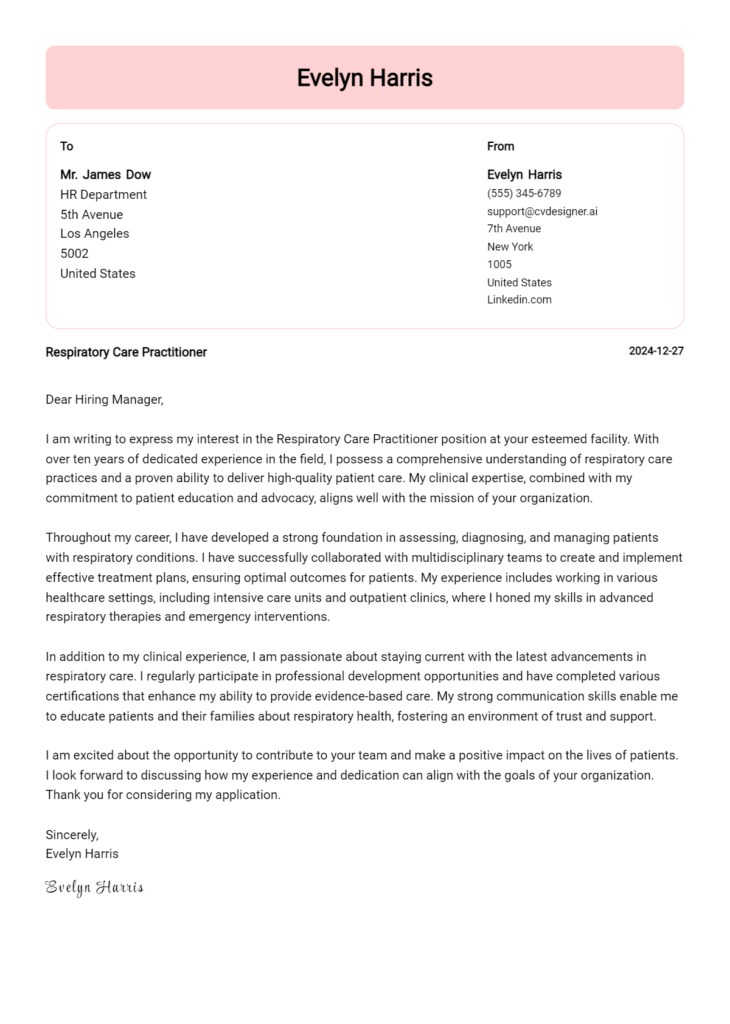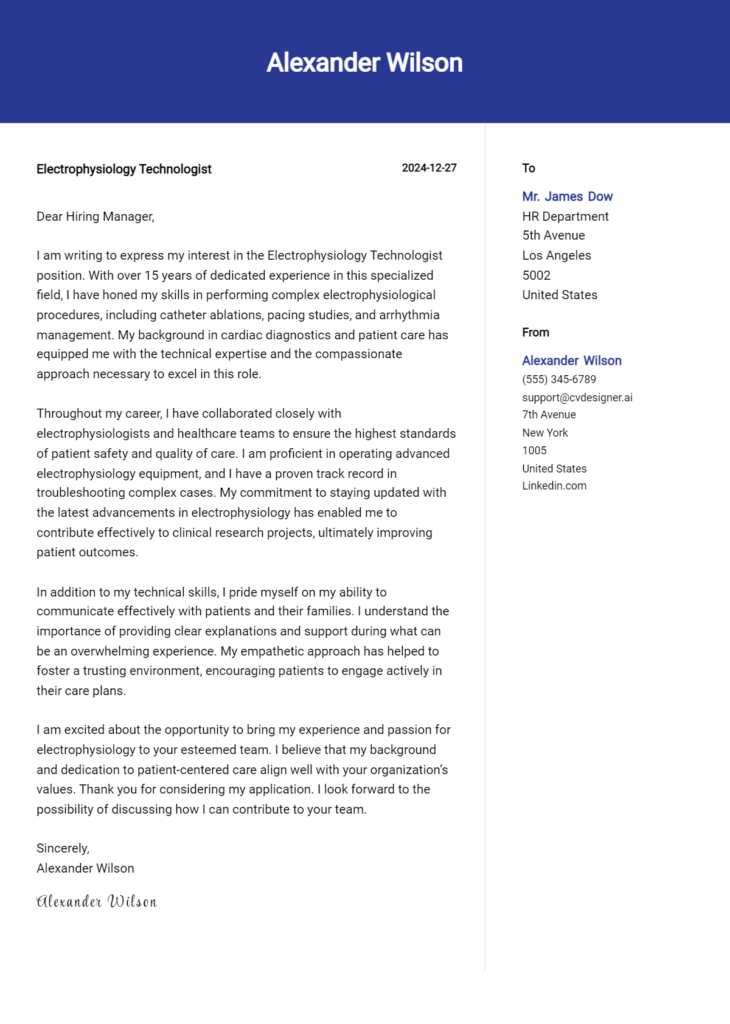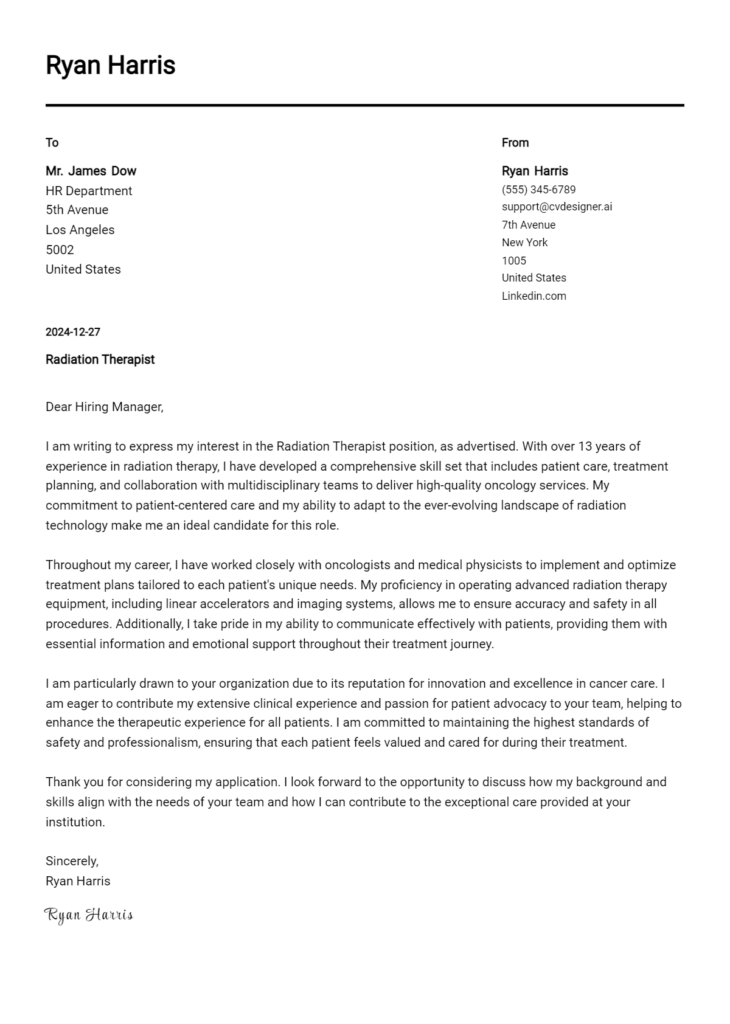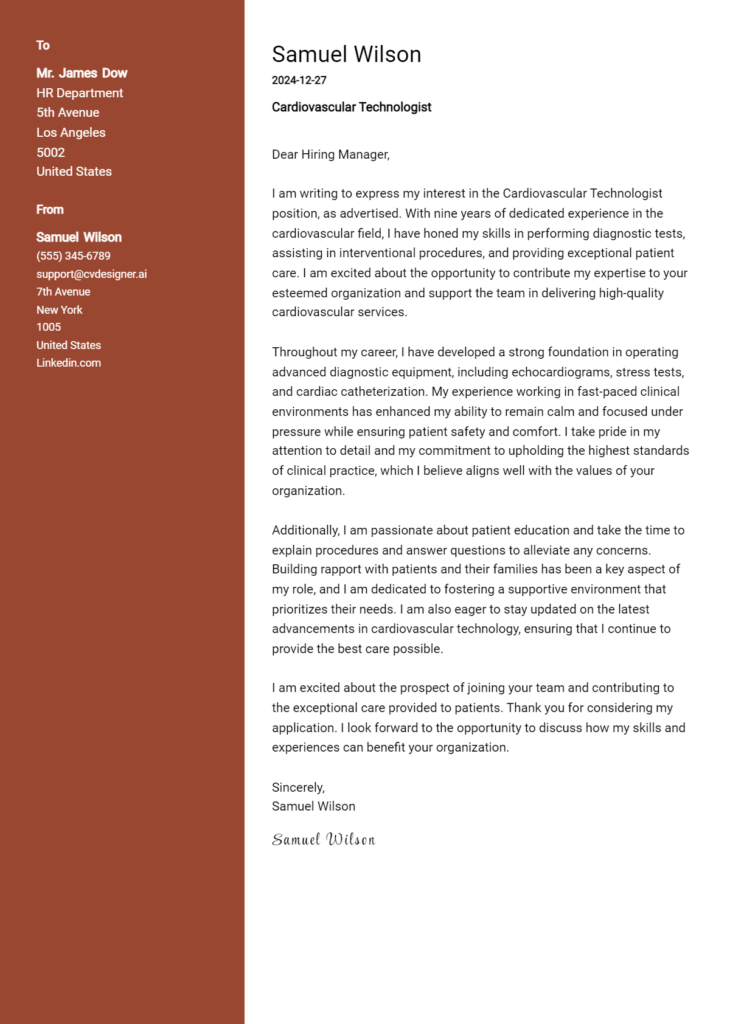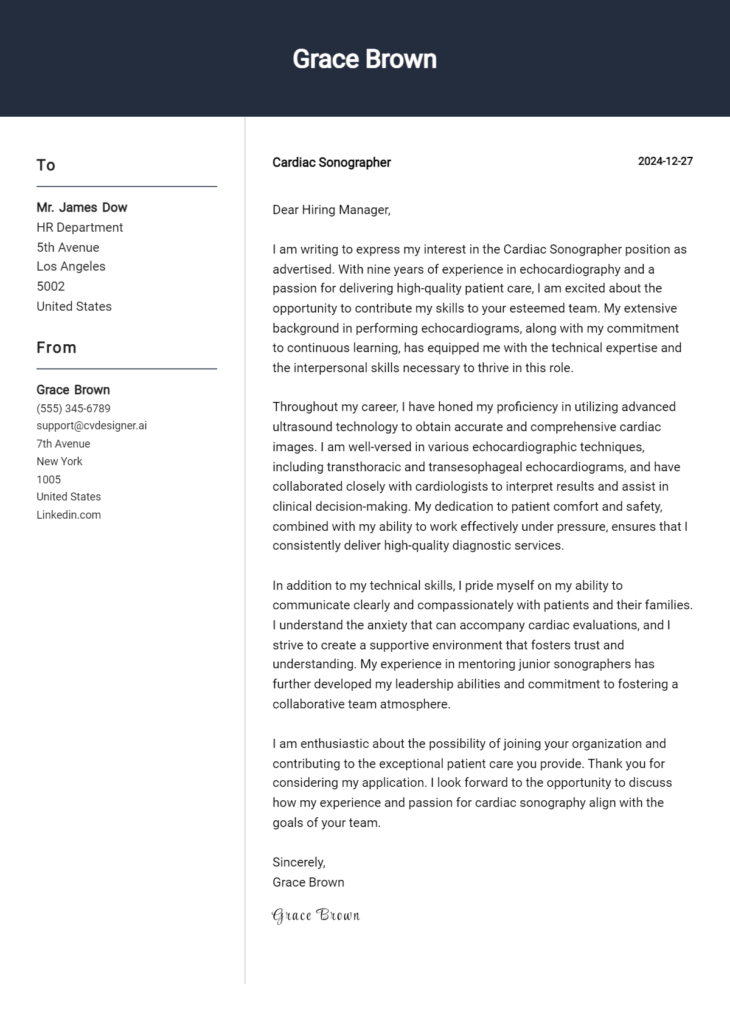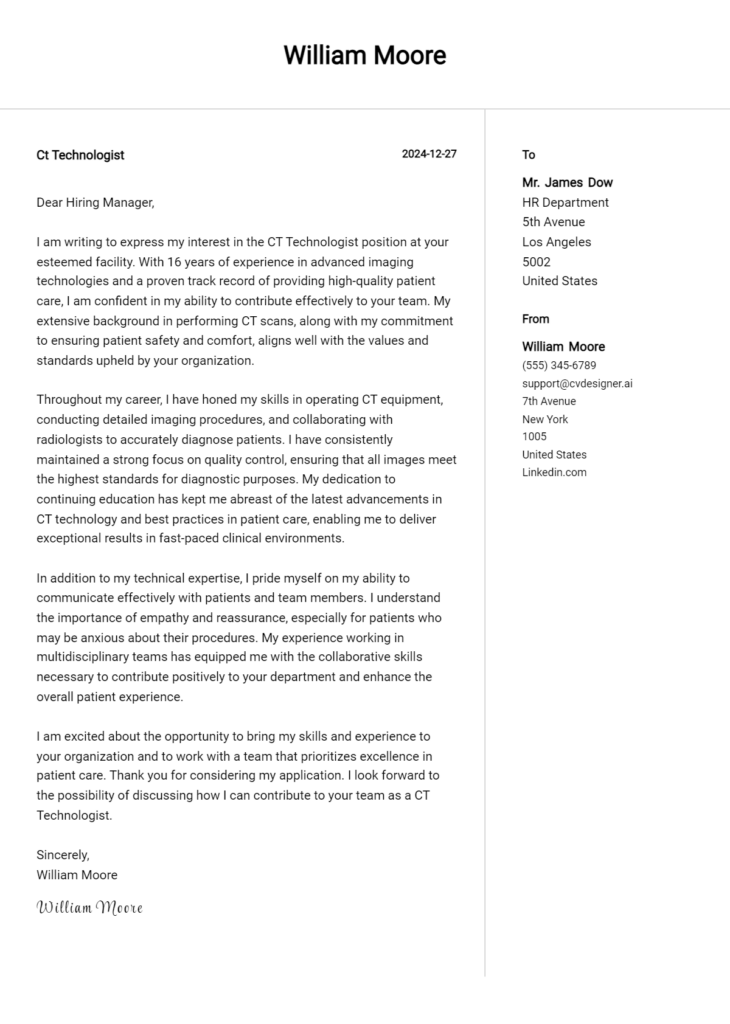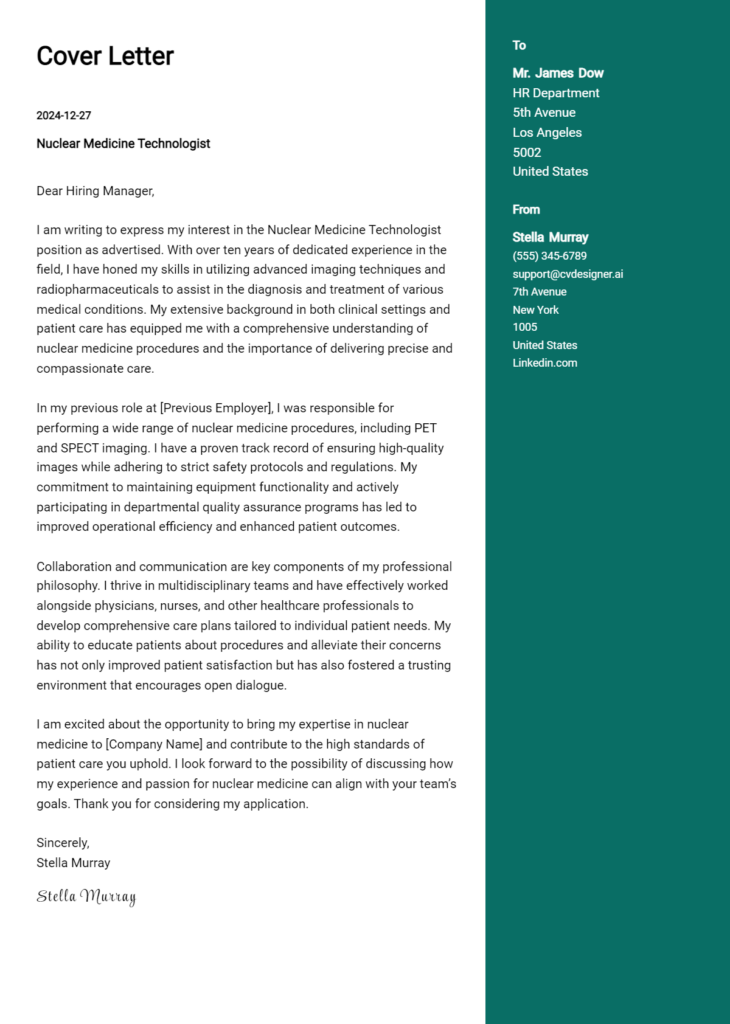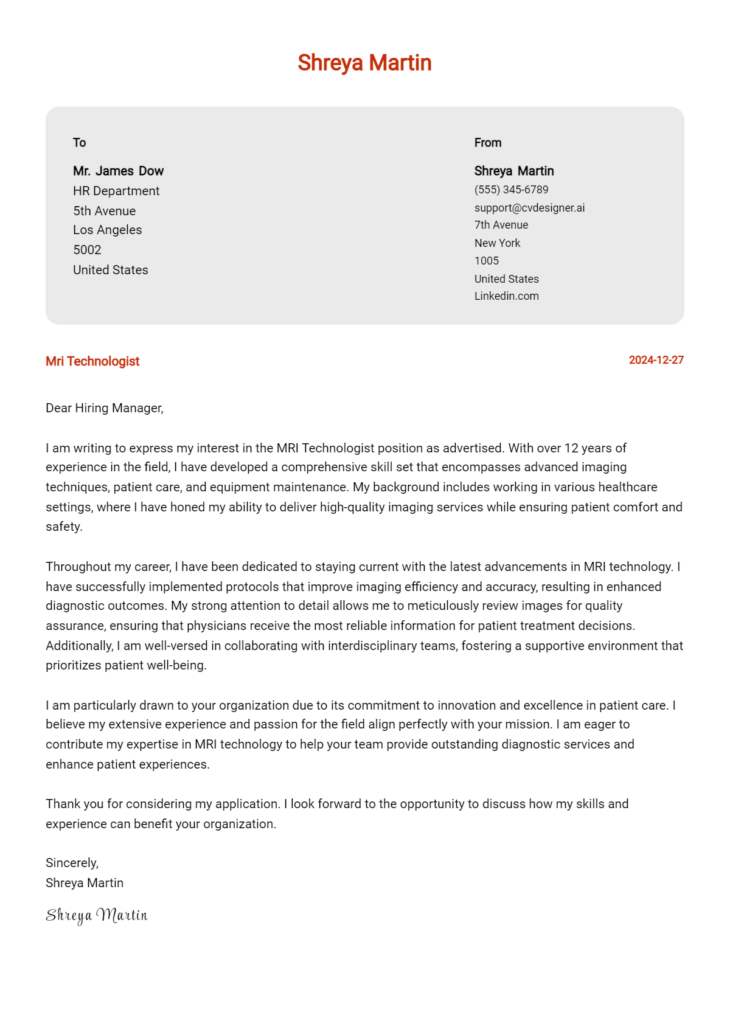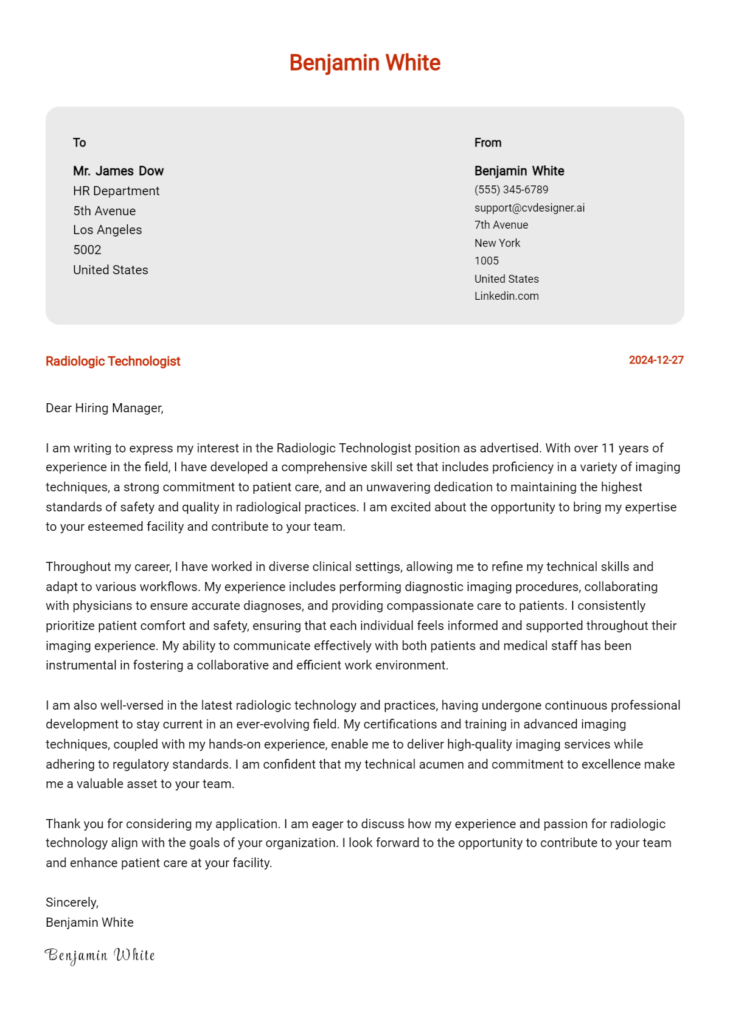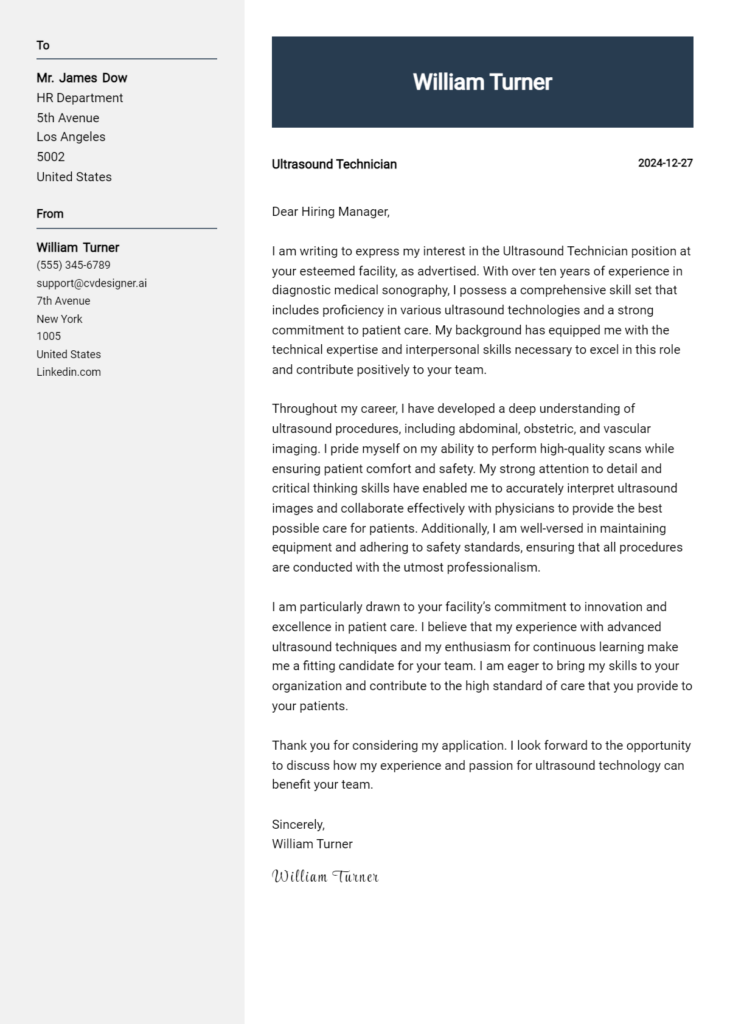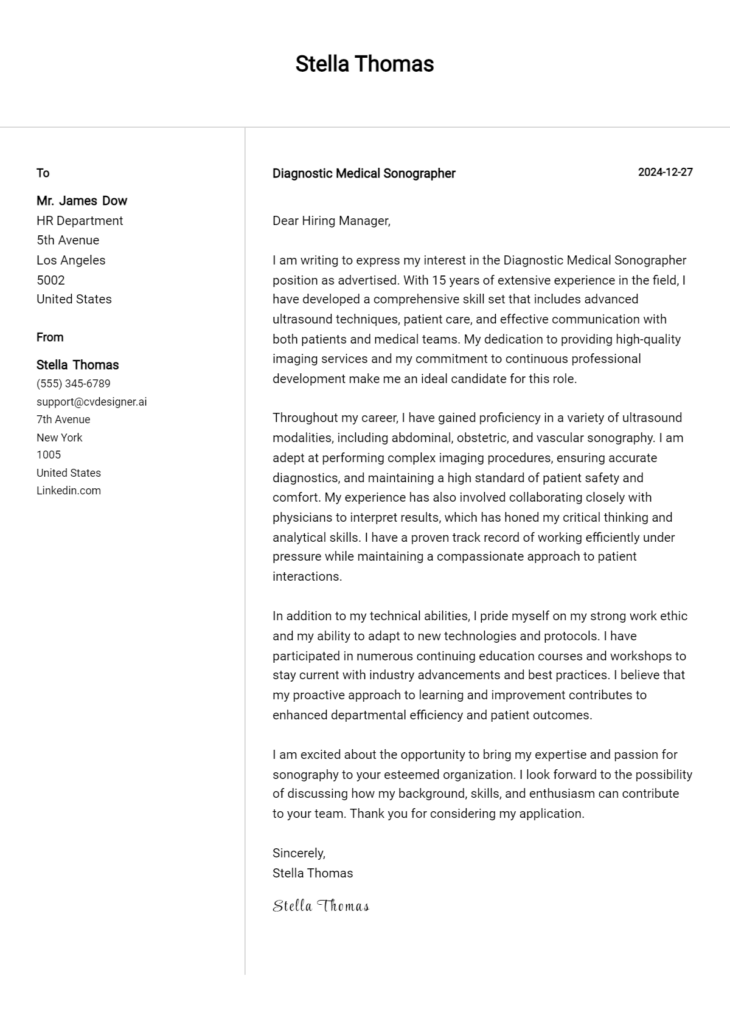Phlebotomist Cover Letter Examples
Explore additional Phlebotomist cover letter samples and guides and see what works for your level of experience or role.
How to Format a Phlebotomist Cover Letter?
Crafting a well-structured cover letter is essential for phlebotomists, as it not only showcases your qualifications but also reflects your professionalism and attention to detail—traits that are paramount in the healthcare field. The way you format your cover letter can make a significant difference in capturing the hiring manager's attention and demonstrating your commitment to patient care and safety.
In this guide, we'll explore how to effectively structure your cover letter, providing valuable insights and phlebotomy-specific examples to help you create an impressive document.
We'll focus on the essential components of a professional cover letter, including:
- Cover Letter Header
- Cover Letter Greeting
- Cover Letter Introduction
- Cover Letter Body
- Cover Letter Closing
Each section plays a crucial role in presenting your qualifications and eagerness for the phlebotomist position. Let’s break down each part and explain how to make your phlebotomist cover letter shine.
Importance of the Cover Letter Header for a Phlebotomist
The cover letter header is a crucial element of any job application, including for a Phlebotomist. It provides essential information at a glance, allowing hiring managers to quickly identify the applicant and their credentials. A well-organized header enhances clarity and professionalism, setting a positive tone for the rest of the document. The header should include your contact information, the date, and the recipient's details, ensuring that all parties are clearly identified and that communication can be easily facilitated.
A strong header conveys attention to detail and respect for the hiring process, while a weak header can detract from the overall impression you make. Below are examples of both a strong and a weak cover letter header for a Phlebotomist.
Strong Example
John Doe 123 Main Street Cityville, ST 12345 (123) 456-7890 johndoe@email.com October 1, 2023 Hiring Manager Health Services Inc. 456 Healthcare Blvd Cityville, ST 67890
Weak Example
John D. 10/1/23 To Whom It May Concern
The Importance of a Cover Letter Greeting for a Phlebotomist
The greeting of your cover letter is a crucial element that sets the tone for the entire document. A well-crafted greeting demonstrates professionalism and shows that you have taken the time to personalize your application by addressing the hiring manager directly. This initial connection can create a positive impression and encourage the reader to engage with the rest of your letter. To avoid sounding generic, it is essential to research the recipient's name and title, as this personal touch can significantly enhance your chances of standing out in a competitive job market.
Here are some tips for crafting an effective greeting:
- Always strive to find the hiring manager’s name through LinkedIn, the company website, or by calling the organization.
- Avoid using "To Whom It May Concern" or "Dear Sir/Madam" as these can come across as impersonal.
- If you cannot find a name, consider using a title or department, such as "Dear Hiring Manager."
Strong Greeting Example
Dear Ms. Johnson,
Weak Greeting Example
To Whom It May Concern,
The Importance of a Compelling Cover Letter Introduction for a Phlebotomist
A well-crafted cover letter introduction is crucial for a Phlebotomist as it serves as the first impression to the hiring manager. This opening paragraph should not only capture attention but also convey the candidate's enthusiasm for the role. It’s an opportunity to briefly highlight key skills and achievements that align with the job requirements, setting the stage for a compelling case for why the candidate should be considered. A strong introduction can distinguish a candidate in a competitive job market, while a weak one might lead to a missed opportunity.
Strong Example
Dear [Hiring Manager's Name], I am excited to apply for the Phlebotomist position at [Company Name] as advertised on [Job Board]. With over three years of experience in a fast-paced clinical environment and a proven track record of successfully performing over 5,000 blood draws with a 98% patient satisfaction rate, I am confident in my ability to contribute positively to your team. My dedication to providing compassionate care and ensuring patient comfort makes me a perfect fit for your organization.
Weak Example
To Whom It May Concern, I am writing to apply for the Phlebotomist position at your organization. I have some experience in drawing blood and think I could do the job well. I hope you consider my application.
Purpose of the Cover Letter Body for a Phlebotomist
The body of a cover letter for a Phlebotomist serves as a crucial platform for candidates to illustrate their relevant skills, experiences, and the unique value they can bring to a healthcare facility. This section provides an opportunity to highlight specific projects, accomplishments, or certifications that demonstrate the candidate's proficiency in blood collection and patient care. Effective cover letter bodies articulate not only the technical skills required for phlebotomy but also the soft skills that enhance patient interaction and teamwork within a clinical setting. A well-crafted body can differentiate a candidate from others by showcasing their dedication to quality care and their ability to contribute positively to the organization.
Strong Example
I am a certified phlebotomist with over three years of experience in high-volume clinical settings. During my tenure at XYZ Medical Center, I successfully managed over 100 blood draws per week, maintaining a 98% patient satisfaction rate. My role involved not only performing venipunctures but also training new staff in proper techniques and safety protocols. I developed a streamlined process that reduced patient wait times by 20%, significantly improving the overall patient experience. I am eager to bring my expertise in patient care and technical skills to your team at ABC Hospital, where I hope to contribute to your commitment to excellence in healthcare.
Weak Example
I have worked as a phlebotomist for a while and I know how to draw blood. I have done many blood tests and I think I would be a good fit for your hospital. My previous job was okay, and I am looking for a new position. I can work with patients and follow instructions. I believe I can help your team.
Cover Letter Closing for a Phlebotomist
The closing paragraph of a cover letter is crucial as it serves to summarize your qualifications, reiterate your enthusiasm for the phlebotomist position, and encourage the hiring manager to take the next steps, such as reviewing your resume or scheduling an interview. A strong closing can leave a lasting impression and reinforce your suitability for the role, while a weak closing may fail to convey confidence or interest.
Strong Example
Thank you for considering my application for the Phlebotomist position at [Company Name]. With my extensive training in blood collection techniques, strong communication skills, and dedication to patient care, I am excited about the opportunity to contribute to your team. I believe my background aligns well with the requirements of the role, and I would appreciate the chance to discuss how I can support your clinic's mission. I look forward to the possibility of an interview and am happy to provide any additional information needed.
Weak Example
Thanks for reading my letter. I hope you look at my resume. I really want the job. Let me know if you want to talk.
Crafting an effective cover letter is crucial for aspiring phlebotomists to stand out in a competitive job market. A well-structured cover letter not only highlights your relevant technical skills and problem-solving abilities but also your understanding of the Software Development Life Cycle (SDLC), teamwork experience, and commitment to continuous learning. Below are some essential tips that will help you create a compelling cover letter tailored for a phlebotomist position.
Tips for Writing a Phlebotomist Cover Letter
Highlight Technical Skills
Emphasize your proficiency in venipuncture, specimen collection, and laboratory procedures. Mention any certifications, such as CPR or phlebotomy training, and provide examples of how you've successfully applied these skills in previous roles. This demonstrates your readiness to handle the technical aspects of the job.Showcase Problem-Solving Abilities
Phlebotomists often face unexpected challenges, whether it’s a patient with difficult veins or an emergency situation. Share a brief anecdote that illustrates your problem-solving skills, such as how you adapted your approach to ensure a successful blood draw while maintaining patient comfort and safety.Demonstrate Knowledge of SDLC
While SDLC is typically associated with software development, understanding the processes behind laboratory information systems can be advantageous. If you have experience with electronic health records (EHR) or laboratory management software, mention it in your cover letter. This shows your ability to integrate technology with clinical practices.Emphasize Teamwork
Phlebotomists work closely with nurses, doctors, and lab personnel. Highlight your ability to collaborate effectively within a team by providing examples of past projects or experiences where teamwork was essential. This can include assisting during busy shifts or participating in team training sessions.Express a Passion for Continuous Learning
The medical field is constantly evolving, and a commitment to ongoing education is vital. Mention any recent training, workshops, or certifications you've pursued to keep your skills sharp. This not only reflects your dedication but also indicates that you are proactive in staying updated with industry standards.
By incorporating these tips into your cover letter, you can effectively communicate your qualifications and enthusiasm for the phlebotomist role. For additional resources, consider exploring cover letter templates and utilizing a cover letter builder to streamline your writing process.
Common Mistakes to Avoid in a Phlebotomist Cover Letter
Crafting a compelling cover letter is essential for standing out in the competitive field of phlebotomy. Avoiding common mistakes can enhance your chances of landing an interview. Here are some frequent pitfalls to watch out for:
- Generic Greetings: Avoid starting with “To Whom It May Concern.” Instead, research the hiring manager's name for a personal touch.
- Lack of Specificity: Failing to mention the specific position or how your skills align with the job requirements can make your application seem unfocused. Tailor your letter to the job description.
- Overly Long Cover Letter: Keep it concise—ideally, one page. Hiring managers appreciate brevity, so focus on your most relevant experiences.
- Neglecting to Proofread: Spelling and grammatical errors can create a negative impression. Always proofread your letter or ask someone else to review it.
- Missing Keywords: Failing to incorporate industry-specific keywords from the job posting can make your application less likely to pass through applicant tracking systems. Be sure to include terms that highlight your skills and experience.
- Focusing on Duties Instead of Achievements: Rather than listing your job duties, focus on your accomplishments and how they benefited previous employers.
- Failing to Show Passion for the Role: A cover letter should convey your enthusiasm for phlebotomy and patient care. Share a brief story or insight that reflects your passion for the field.
For more guidance on crafting your cover letter, consider checking out these cover letter examples and learning about the best cover letter format to use.
Cover Letter FAQs for Phlebotomist
What should I include in my cover letter as a Phlebotomist?
When crafting your cover letter, focus on highlighting your relevant skills and experiences. Begin with a strong opening that states your interest in the position and how you learned about it. Emphasize your training in phlebotomy, any certifications you hold (like CPR or certification from a recognized phlebotomy program), and your hands-on experience in drawing blood and managing patient care. Discuss your interpersonal skills, as they are critical in ensuring patient comfort and trust. Lastly, express your enthusiasm for contributing to the healthcare team and mention your availability for an interview to discuss your qualifications further.
How can I make my cover letter stand out?
To make your cover letter stand out, personalize it for the specific job and employer. Research the facility or practice you are applying to and include details about their values or mission that resonate with you. Use concrete examples of your accomplishments, such as the number of successful blood draws you’ve performed or any recognition you’ve received for your patient care skills. Ensure your writing is clear, professional, and free of errors. A unique opening statement that reflects your passion for phlebotomy can also capture the reader's attention and set the tone for the rest of your letter.
Should I address my cover letter to a specific person?
Yes, addressing your cover letter to a specific person is highly recommended. It shows that you have taken the time to research the organization and are genuinely interested in the position. If the job listing does not specify a name, consider checking the company’s website or calling the front office to inquire. Using a specific name (e.g., "Dear Ms. Smith") instead of a generic greeting (e.g., "To Whom It May Concern") demonstrates professionalism and can help establish a connection with the hiring manager. If you cannot find a name, using "Dear Hiring Manager" is an acceptable alternative.
How long should my cover letter be?
Your cover letter should ideally be one page long, consisting of three to four paragraphs. Keep it concise and focused on your qualifications and experiences that are most relevant to the phlebotomist position. Aim for around 250-400 words; this length allows you to cover your main points without overwhelming the reader. Use clear and professional language, and avoid unnecessary filler content. Each paragraph should have a specific purpose: the introduction, your qualifications, your skills, and a conclusion that invites further discussion. Remember, clarity and brevity are key to making a strong impression.
Build your Cover Letter in minutes
Use an AI-powered cover letter builder and have your letter done in 5 minutes. Just select your template and our software will guide you through the process.

